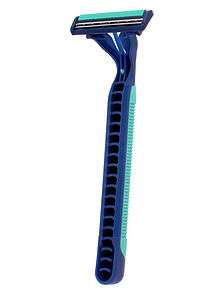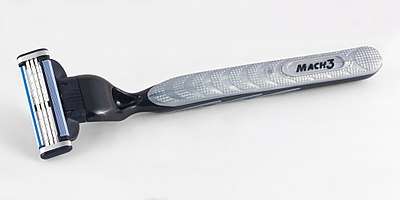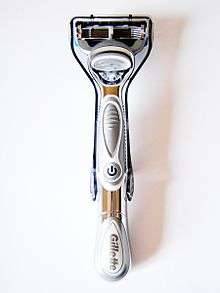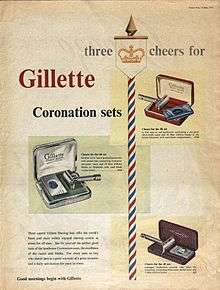Gillette
 | |
| Product type | Safety razors |
|---|---|
| Owner | Procter & Gamble |
| Country | Boston, Massachusetts, U.S. |
| Introduced | September 28, 1901[1] |
| Markets | Worldwide |
| Previous owners | The Gillette Company |
| Tagline | "The Best a Man Can Get" |
| Website |
www |

Gillette is a brand of men's and women's safety razors and other personal care products including shaving supplies, owned by the multi-national corporation Procter & Gamble (P&G).
Based in Boston, Massachusetts, United States, it was owned by The Gillette Company, a supplier of products under various brands until that company merged into P&G in 2005. The Gillette Company was founded by King C. Gillette in 1901 as a safety razor manufacturer.[2]
Under the leadership of Colman M. Mockler Jr. as CEO from 1975–91, the company was the target of three takeover attempts, from Ronald Perelman and Coniston Partners.[3] On October 1, 2005, Procter & Gamble finalized its merger with the Gillette Company.
The Gillette Company's assets were incorporated into a P&G unit known internally as "Global Gillette". In July 2007, Global Gillette was dissolved and incorporated into Procter & Gamble's other two main divisions, Procter & Gamble Beauty and Procter & Gamble Household Care. Gillette's brands and products were divided between the two accordingly. The Gillette R&D center in Boston, Massachusetts, and the Gillette South Boston Manufacturing Center (known as "Gillette World Shaving Headquarters"), still exist as functional working locations under the Procter & Gamble-owned Gillette brand name.[4] Gillette's subsidiaries Braun and Oral-B, among others, have also been retained by P&G.
In some languages, the brand has become the genericized trademark for all razor blades, for example in Czech (žiletka), Estonian (žilett), Latvian (žilete), Macedonian (žilét), Polish (żyletka), and Serbo-Croatian (žilet).
Product history
Double-edged safety razors

The first safety razor using the new disposable blade went on sale in 1903.[4] Gillette maintained a limited range of models of this new type razor until 1921 when the original Gillette patent expired. In anticipation of the event, Gillette introduced a redesigned razor and offered it at a variety of prices in different cases and finishes, including the long running “aristocrat". Gillette continued to sell the original razor but instead of pricing it at $5, it was priced at $1, making a Gillette razor truly affordable to every man regardless of economic class. In 1932 the Gillette Blue Blade, so-named because it was dipped in blue lacquer, was introduced. It became one of the most recognizable blades in the world. In 1934 the "twist to open" (TTO) design, was intuitiuted, which featured butterfly-like doors that made blade changing much easier than it had been, wherein the razor head had to be detached from the handle.
Razor handles continued to advance to allow consumer to achieve a closer shave. In 1947, the new (TTO) model, the "Super Speed", was introduced. This was updated in 1955, with different versions being produced to shave more closely — the degree of closeness being marked by the color of the handle tip.
In 1955, the first adjustable razor was produced. This allowed for an adjustment of the blade to increase the closeness of the shave. The model, in various versions, remained in production until 1988.[5]
.jpg)
The Super Speed razor was again redesigned in 1966 and given a black resin coated metal handle. It remained in production until 1988. A companion model the,"Knack", with a longer plastic handle, was produced from 1966 to 1975. In Europe, the Knack was sold as "Slim Twist" and "G2000" from 1978 to 1988, a later version known as "G1000" was made in England and available until 1998. A modern version of the Tech, with a plastic thin handle, is still produced and sold in several countries under the names 7 O'clock, Gillette, Nacet, Minora, Rubie and Economica.
Discontinued products
- Techmatic was a single blade razor introduced in the mid-1960s. It featured a disposable cartridge with a razor band which was advanced by means of a lever. This exposed an unused portion the band and was the equivalent of five blades.
- Adjustable Techmatic was a version of the Techmatic dating from 1970. The adjustable version featured user-selection of shave closeness on the cartridge. The adjustable version was interchangeable with the non-adjustable version. Both versions of the Techmatic and their cartridges have been discontinued.
- Trac II was the world's first two-blade razor, debuting in 1971. Gillette claimed that the second blade cut the number of strokes required and reduced facial irritation.
- Trac II Plus was an identical model but adds a lubricating strip at the top of the blade. The blades and handles were interchangeable.
- The European versions of the Trac II and Trac II Plus were known as the GII and GII Plus respectively.
- Atra (known as the Contour, Slalom, Vector in some markets) was introduced in 1977 and was the first razor to feature a pivoting head, which Gillette claimed made it easier for men to shave their necks.
- Atra Plus featured a lubricating strip, dubbed Lubra-Soft.
Current products
- Good News! is a currently produced first disposable, double-blade razor, released in 1976.
- The Good News! comes in three forms: the "Original", the "Good News! Plus", which includes a lubricating strip, and the "Good News! Pivot Plus", which features a lubricating strip and a pivoting head.
- Gillette Sensor debuted in 1990, and was the first razor to have spring-loaded blades. Gillette claimed the blades receded into the cartridge head, when they make contact with skin, helping to prevent cuts and allowing for a closer shave.
- The Sensor for Women was released around the same time and was nearly identical, but had a wider cartridge head.
 Gillette Blue II razor, circa 2007
Gillette Blue II razor, circa 2007
- Sensor Excel was released in 1993. This featured "Microfins", a piece of rubber with slits at the bottom of the cartridge which Gillette claimed this helped to raise facial hairs, making for a closer shave.
- Sensor 3 had three blades instead of two. All Sensor handles can use all Sensor cartridges.
- Blue II is a line of disposable razors. In Latin America, it was marketed as the Prestobarba.
- Blue 3 is a line of three-blade razors, cheaper version of Sensor 3 (Sensor compatible). It's only available also in disposable variant.
- Custom Plus is a series of disposable razors
- The Custom Plus comes in many varieties: the "Fixed Disposable razor", the "Pivot Disposable razor", the "Custom Plus 3 Sensitive Disposable", and the "Custom Plus 3 Soothing Disposable".
- Mach 3 - the first three-blade razor, introduced in 1998, which Gillette claims reduces irritation and requires fewer strokes.
- The Mach 3 featured five improved microfins and spring blades, a pivoting head with greater flexibility and a blue lubrication strip that faded with usage to encourage users to change their blades more frequently.
- Mach 3 disposable - the Mach 3 with a plastic handle.
- Mach 3 Turbo - this razor was released in late 2001. It had ten microfins as opposed to the five on the original, a new grip and claims improved lubrication and "anti-friction" blades.
- All Mach 3 blades are interchangeable between the three products in the range, so it is possible to use the Mach3 Turbo blades on a Mach3 razor.
- Mach 3 Turbo Champion has a slightly different handle design.
 Gillette Mach 3 razor, circa 2015
Gillette Mach 3 razor, circa 2015
- Mach 3 Turbo Champion has a slightly different handle design.
- Mach 3 Power is a battery-powered version of the Mach3 Turbo razor which can also be used with the power switched off. The blades differ from Mach 3 Turbo with a new coating which Gillette describes as "PowerGlide".
- Mach 3 Sensitive was awarded a 2012 Best New Product Award after being voted 'Best in Show' in the program's awards in Mexico.
- The lubrication and microfins are identical to Mach3Turbo. The Mach3 Power Nitro has a slightly different handle design.
- Venus is a division of razors for women.
- Venus Divine is a version of the Mach3 Turbo for women.
- Venus Vibrance is a version of the M3Power for women. Venus blades are interchangeable across the line.
- Venus Embrace is a five-bladed razor with a ribbon of moisture surrounding the blades.
- Venus Breeze is a three-blade razor with shave gel bars built into the head of the razor.
- Another version of the Breeze, the Venus Spa Breeze, is essentially the same as the Breeze, but with a white tea scent to the shave gel bars.[6]
- Venus ProSkin Moisture Rich, launched in January 2011 in the United States, is an updated version of the Breeze, featuring Moisture Rich shave-gel bars that are enhanced with a triple blend of body butters.[7]
- Gillette Fusion is a five-bladed razor released in 2006. The Fusion has five blades on the front, and a single sixth blade on the rear for precision trimming. Its marketing campaign was fronted by the sports stars Roger Federer, Thierry Henry and Tiger Woods.
 Gillette Fusion ProGlide Power
Gillette Fusion ProGlide Power
- Gillette Fusion Power is a motorized version of the Fusion. The Fusion Power is battery-powered and emits "micropulses" that are claimed to increase razor glide.[8]
- Fusion Power Phantom - the Fusion Power Phantom (Stealth in UK) was released in February 2007 and features a redesigned handle with a darker color scheme than the original.
- Fusion Power Phenom was released in February 2008. It has a blue and silver color scheme.[9]
- Fusion ProGlide and Fusion ProGlide Power were launched on June 6, 2010, in North America.
- The ProGlide series feature re-engineered blades with edges that are thinner than Fusion and are finished with low-resistance coating which the company claims allow the blades to glide more easily through hair.[10]
- Fusion Proshield Flexball released in November 2015: the blades have lubrication before and after the blade so that it protects the skin while shaving.
- Fusion Power Gamer (known as "Cool White" in some markets)
- Fusion ProGlide FlexBall released in June 2014
- The ProGlide FlexBall has a handle allows the razor cartridge to pivot. Gillette claims that it means 20% fewer missed hairs, the ability to cut hairs 23 microns shorter, and 23% increased skin contact.
Criticism
The desire to release ever more expensive products, each claiming to be the best ever, has led Gillette to make disputed claims for its products. In 2005, an injunction was brought by rival Wilkinson Sword which was granted by the Connecticut District Court which determined that Gillette's claims were both "unsubstantiated and inaccurate" and that the product demonstrations in Gillette's advertising were "greatly exaggerated" and "literally false". While advertising in the United States had to be rewritten, the court's ruling does not apply in other countries.[11]
Procter & Gamble (P&G) shaving products have been under investigation by the UK Office of Fair Trading as part of an inquiry into alleged collusion between manufacturers and retailers in setting prices. According to the Daily Mail newspaper, an industry insider claimed that the Fusion range of blades cost only £0.05 each to manufacture, yet sold for up to £2.43: a mark-up price of more than 4,750%.[12]
Gillette was fined by Autorité de la concurrence in France in 2016 for price fixing on personal hygiene products.[13]
Net worth
In 1999, Gillette, as a company, was worth US$43 billion, and it was estimated that the brand value of Gillette was worth US$16 billion. This equated to 37% of the company's value, which was the same as DaimlerChrysler, one of the world's largest car manufacturers at the time.[14]

Promotions
Gillette has a long history of promotions for its products, especially towards young men. Current promotions include sponsorship of sports events such as Major League Baseball (since the 1940s, when it was the only sponsor for World Series television broadcasts) and the England national rugby league team, along with the Rugby League Four Nations. Gillette ships a razor to males in the United States around the time of their 18th birthday; as of 2010 Gillette has been sending the Fusion ProGlide. Athletes such as Roger Federer, Tiger Woods, Shoaib Malik, Derek Jeter, Thierry Henry, Kenan Sofuoglu, Park Ji-Sung, Rahul Dravid, and Michael Clarke are sponsored by the company.[15]
There were calls to boycott Gillette products given their association with Thierry Henry, after a handball by Henry went undetected by referees and allowed France to knock Ireland out of qualifying for the 2010 FIFA World Cup. Marketing experts have highlighted "the curse of Gillette", given the mishaps that happen to sports stars associated with the brand.[16]
In popular culture
- Saturday Night Live featured a triple-blade razor in 1975, 23 years before the Mach3, with the slogan "The Triple-Trac. Because you'll believe anything". Not to be outdone, satirical newspaper The Onion printed a mock-commentary by Gillette's president after Wilkinson/Schick introduced their Quattro razor in 2004, three years before the Fusion was introduced, entitled Fuck Everything, We're Doing Five Blades.[17]
- Mad TV also featured a parody poking fun at Gillette's Mach3 line of products. Mad TV called the product the "Spishak Mach 20".
- Gillette continues to hold the naming rights to Gillette Stadium, which is home to the NFL five-time Super Bowl champions New England Patriots and the MLS New England Revolution.
- Eh Joe (1965), an avant-garde screenplay for television penned by the minimalist writer Samuel Beckett, references Gillette razors several times in its script.
- The James Bond film Goldfinger features a Gillette Slim 195 Adjustable twist to open (TTO) razor which contains the homing device Bond used while aboard the title character's private jet.
- British comedian Michael McIntyre made jokes parodying the brand's adverts during his Mock The Week appearance, saying: "Our closest shave yet. In fact, it's too close. It acts like a bacon slicer. Go back to using the previous one."
- In laser research and development, a "Gillette" is a non-standard measurement used as a rough estimate of a particular device's penetrative ability; a "four-Gillette laser", for example, can burn through four Gillette safety razor blades.[18]
- Gilette is used as a generic mark in some languages to mean any kind of razor.
Canadian headquarters
Until the late 1980s, Gillette Canada's headquarters were in the Montreal suburb of Mont-Royal, Quebec until they moved west to another Montreal suburb in Kirkland. The Kirkland offices were closed in 1999 and Gillette Canada moved to Mississauga, Ontario, a Toronto suburb following the Gillette acquisition of Duracell. The Mississauga offices were closed in 2005-06 after Procter & Gamble acquired Gillette, and Gillette's Canadian headquarters are located in downtown Toronto with parent Procter & Gamble on Yonge St.
References
- ↑ SRINIVASAN, R. CASE STUDIES IN MARKETING: THE INDIAN CONTEXT. PHI Learning Pvt. Ltd. ISBN 9788120349964.
- ↑ Gillette, K.C. (February 1918). "The Gillette Blade". 1 (4): 9.
- ↑ Gale Directory of Company Histories: The Gillette Company, answers.com; accessed August 22, 2014.
- 1 2 "Gillette history". gillette.com. Retrieved August 22, 2014.
- ↑ "Vintage Gillette Adjustable Double Edge Razors". GilletteAdjustable.com. Retrieved 12 March 2017.
- ↑ "Gillette Venus: Venus Spa Breeze 2-in-1 Razor" Archived 2011-07-11 at the Wayback Machine., gillettevenus.com; accessed August 22, 2014.
- ↑ "Gillette Venus: ProSkin MoistureRich Razor" Archived 2011-03-06 at the Wayback Machine., gillettevenus.com; accessed August 22, 2014.
- ↑ "Gillette - Men's Razors & Shaving Products". gillette.com.
- ↑ "Gillette Unveils Newest Members of Its Gillette Young Guns Lineup" (Press release). Gillette. February 11, 2008. Archived from the original on September 7, 2012. Retrieved February 15, 2008.
- ↑ Gillette Fusion ProGlide Shaving Razor for Men, Official website; accessed August 22, 2014.
- ↑ "Truth in advertising", Gizmag; accessed August 22, 2014.
- ↑ "Sharp practice? The razor heads that cost just 5p to make, but sell for £2.43 each", Daily Mail, June 8, 2009
- ↑ "Huge price-fixing fine is upheld". The Connexion. 28 October 2016. Archived from the original on 9 February 2017.
- ↑ Jane Pavitt. Brand New, September 2000. ISBN 0-691-07061-X.
- ↑ Variant. "Gillette Endorsements - Athletes Who Are Endorsed by Gillette". www.athletepromotions.com. Retrieved 2016-08-04.
- ↑ "Henry, Woods, Federer: The curse of Gillette". The Independent. London, UK. November 29, 2009. Retrieved May 3, 2010.
- ↑ James M. Kilts (2004-02-18). "Fuck Everything, We're Doing Five Blades". The Onion.
- ↑ Rachel Zurer (December 27, 2011). "Three Smart Things About Lasers". Wired. Retrieved May 21, 2015.
Further reading
- "King C. Gillette, The Man and His Wonderful Shaving Device" by Russell Adams (1978), published by Little Brown & Co. of Boston, Massachusetts, U.S.
- McKibben, Gordon (1998). Cutting Edge: Gillette's Journey to Global Leadership. Harvard Business School Press. ISBN 0-87584-725-0.
- The Gillette Company History (thefundinguniverse.com)
External links
![]()